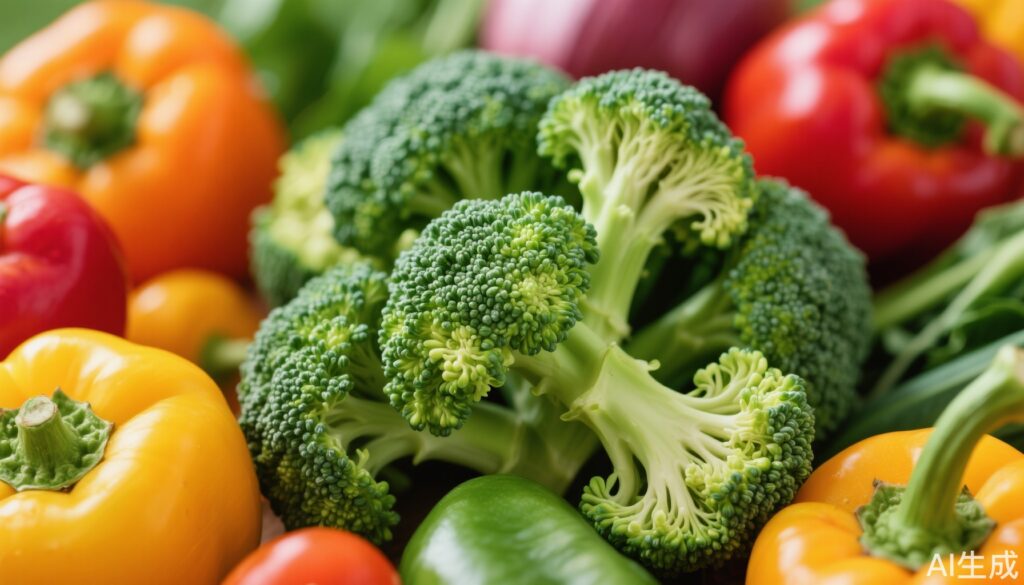Introduction to Broccoli’s Nutritional Value
In recent years, broccoli has gradually become a staple on dining tables worldwide. It is even dubbed the “poor man’s doctor” and “nature’s medicine” in Western cultures. Not only is it delicious, but its nutritional value is exceptionally high. For example, 100 grams of broccoli contains about 4.1 grams of protein, which is three times that of cauliflower and four times that of tomatoes. Additionally, it is rich in essential minerals and vitamins such as vitamin C, calcium, phosphorus, iron, potassium, zinc, and manganese, making it a true “nutrition champion” among vegetables.
In 2024, researchers from the Spanish Society of Nutrition and Dietetics published a notable study in the esteemed nutrition journal “Nutrients,” unveiling new insights about broccoli’s health benefits.
Six Reasons to Love Broccoli
The study analyzed data from over 700,000 people and found that increased broccoli consumption is associated with a lower overall cancer risk. Case-control studies showed a 36% reduction in cancer risk, while cohort studies indicated an 11% reduction.
Broccoli, as a member of the cruciferous vegetable family, uniquely contains organic sulfur compounds called glucosinolates, also known as mustard oil glycosides or simply sulfur glycosides. Research shows these compounds degrade into isothiocyanates, which exhibit biological activities such as tumor prevention and inhibition, antioxidant effects, antibacterial properties, and immune system regulation.
1. Reduces Cardiovascular Disease Risk
Broccoli is rich in flavonoids, which not only act as antioxidants and infection preventers but also inhibit the oxidation of low-density lipoprotein (LDL) cholesterol and plaque buildup in arteries. This makes broccoli an effective vascular cleanser, enhancing vascular wall resilience and reducing the incidence of heart disease and stroke.
2. Anti-inflammatory Effects
Broccoli contains the anti-inflammatory nutrient sulforaphane (SFN) in the highest amounts among common vegetables, with approximately 2.3 grams per 100 grams. Studies suggest SFN possesses anti-tumor effects by suppressing early inflammation development, thereby supporting the body’s anti-inflammatory response.
3. Regulates Blood Pressure, Blood Sugar, and Cholesterol
Broccoli is high in soluble fiber, aiding in removing intestinal waste and lowering cholesterol levels, which helps control blood lipid profiles. Its flavonoids further prevent cholesterol oxidation, reducing risks of arteriosclerosis, stroke, and related conditions. Additionally, as a high-fiber vegetable, broccoli slows glucose absorption in the gastrointestinal tract, assisting in blood sugar control and potentially benefiting diabetes management.
4. Strengthens Bones
Each 100 grams of broccoli provides 50 milligrams of calcium and 101.6 micrograms of vitamin K, both vital for bone strength. These nutrients help middle-aged and elderly individuals increase bone density, improve bone quality, and maintain skeletal health. For people allergic to milk or lactose intolerant, broccoli offers a valuable alternative calcium source.
5. Antioxidant and Immune-Boosting Properties
Broccoli is also rich in dietary fiber, vitamin C, beta-carotene, and other antioxidants. This balanced nutrient profile supports optimal bodily functions, enhances metabolism, and strengthens the immune system.
6. Protects and Enhances Vision
Broccoli contains very high levels of carotenoids, reaching 7,210 micrograms per 100 grams, surpassing that of carrots by a significant margin. It is also abundant in lutein, both essential in protecting eye health and preventing eye diseases.
How to Cook Broccoli for Maximum Nutrition
While broccoli is highly nutritious, proper preparation and cooking methods are crucial to preserve its benefits.
Broccoli with Mixed Mushrooms Recipe
Ingredients: Broccoli, straw mushrooms, shiitake mushrooms, carrots, green onions, ginger, cooking wine, cornstarch slurry, oyster sauce, soy sauce.
Method:
- Boil water with green onions and ginger briefly. Prepare a bowl with salt, chicken essence, and a little cooking wine.
- Pour the boiled onion-ginger water into the bowl, add a few drops of cooking oil, and stir. Soak the cleaned mushroom pieces in this mixture to enhance flavor and remove odors.
- Slice carrots thinly and cut broccoli into small florets. Blanch both separately and set aside.
- Heat oil in a pan, stir-fry mushrooms over low heat until edges turn golden and fragrant.
- Move mushrooms to the side, add oyster sauce and cooking wine to the pan base, stir-fry until oyster sauce is evenly distributed. Add minced ginger and green onions, soy sauce, and a bit more cooking wine, then stir well.
- Add about 45–50 grams of water and simmer briefly to deepen mushroom flavor.
- Increase heat, add carrots, stir-fry briefly, then add cornstarch slurry while tossing to thicken the sauce evenly.
Cold Broccoli Salad Recipe
Ingredients: Broccoli, carrots, fresh mushrooms, scallions, garlic (white skin), salt, vinegar, sesame oil.
Method:
- Wash broccoli and cut into small pieces. Blanch briefly in boiling water, then spread out to cool.
- Dice carrots and slice mushrooms, blanch briefly.
- Chop scallions and mince garlic.
- Combine broccoli, carrots, mushrooms, scallions, and garlic. Season with salt, vinegar, and sesame oil, then mix well before serving.
Important Tips When Handling and Cooking Broccoli
1. Avoid these common mistakes while cooking broccoli:
- Inadequate washing: Broccoli and cauliflower have tight crevices that can harbor insect eggs and parasites. Simply rinsing with water is insufficient. The correct method is to break broccoli into small florets, soak in saltwater for about 15 minutes, then rinse thoroughly with running water.
- Discarding stems: Many people discard broccoli stems, but they contain higher levels of flavonoids and dietary fiber than the florets. Cut stems into small pieces and cook together with florets to avoid wasting nutrients.
- Overcooking: Prolonged stir-frying or boiling depletes vitamins and sulforaphane, reducing health benefits. Studies from the University of Illinois suggest steaming broccoli preserves the most nutrients and increases glucosinolate content.
2. Food combinations to avoid with broccoli:
- Milk: Consuming milk immediately before or after broccoli intake can impair calcium absorption and reduce nutritional value.
- Zucchini: Zucchini contains enzymes that break down vitamin C, which may hinder the body’s absorption of vitamin C from broccoli.
- Animal liver (e.g., pork or chicken liver): Broccoli’s dietary fiber can bind with copper, iron, and zinc in animal livers, forming indigestible compounds that reduce mineral absorption.


